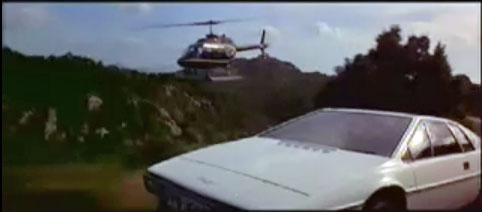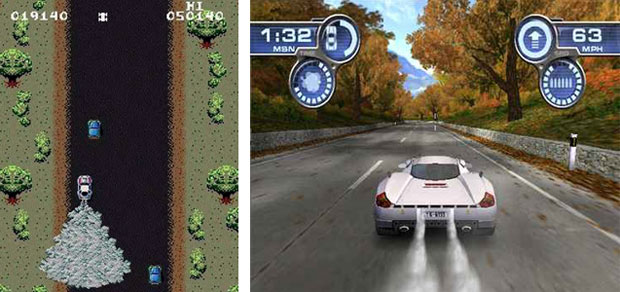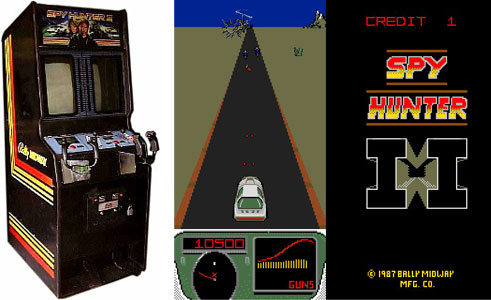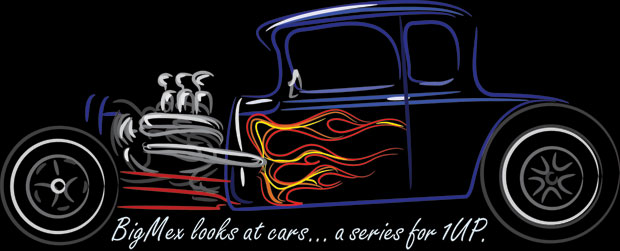
If you were a serious gamer of the 80's then you know that Spy Hunter by Bally / Midway was possibly the best action driver the company has ever made. Released in 1983 the game has gone on to see countless releases on consoles, PC's and handheld systems. The arcade original is still possibly the best way the game should be played.
Spy Hunter broke the mold of the racing experience. It was a top-down driver, in the vein of the Sega's original Monaco GP but the similarities ended there. This game included weapons and a narrative. You were a spy making his way through hostile territory. Your car could gain special weapons to use against enemies, from smoke screens and oil slicks to machine guns and missiles. Each of these weapons would come in handy against certain enemies. Some opponents were heavily armored cars immune to bullets, they required drivers to shove them off the road, one of the harder enemies was a helicopter that could only be hit with missiles. The steering wheel found in most arcade racers had been replaced with something that looked more like a fighter plane control, with trigger and thumb buttons all used to fire the different weapons. The game also featured multi-path roads, some of which lead to rivers where the car would be switched out for a high-speed boat.

The entire experience was very reminiscent (read: lifted) from the famous Lotus Esprit chase in the 1977 James Bond film The Spy Who Loved Me. The sleek exotic car with hidden weapons and even the ability to turn into a submersible. I'm glad that the arcade experience focused on the car chase rather than the cheesy Roger Moore character. The game was very challenging. Very few people could get far enough into the game to try out all the weapons, let alone ever see the boat. All that experienced the game enjoyed the memorable theme, taken from the Peter Gunn television series. If you ask any arcade gamer about Spy Hunter then at the very least they should be able to hum the classic tune. A clever sense of nostalgia prompted Pontiac to create a commercial based on Spy Hunter.
Midway made sure the game was ported on multiple consoles and even followed up with a pinball release in 84. In 2001 they decided to relaunch the franchise and made an updated version of Spy Hunter for the Xbox and PS2. They added a more epic narrative and fleshed out the world of the G-6155 Interceptor. Creating a rival faction and a doomsday plot right out of a big budget motion picture to pull gamers through the experience. The release by developers Paradigm Entertainment was well-done. The classic elements featured in the original returned along with some updated elements. Rather than switch vehicles the new-and-improved Interceptor could transform on the fly and become a boat for river sections and turn into a motorcycle if it took too much damage. The pace was rapid and the game had a fun arcade quality to it.

The sequels to the new Spy Hunter didn't sit well with critics. Angel Studios took over for Paradigm and made a decent game with 2003's Spy Hunter 2. The Interceptor could now transform into other vehicles and even featured "boss" battles against massive vehicles. However by the time Spy Hunter: Nowhere to Run came out the franchise went bust. The driver of the Interceptor, Alex Decker, was doing missions outside of the car in a loose GTA feel. The driving portions weren't as well made as the previous games. Players felt that the experience was lacking because Midway had broken up the game into two lacking experiences rather than one solid game. Most could tell that Midway wanted to turn the Spy Hunter game into a film franchise and were pushing the material into places that didn't suit it. The game worked when it was a car chase pulled from a spy film highlight. Not when it was trying to become the spy film itself.

This wouldn't be the first time that Midway had failed the IP. The arcade sequel, Spy Hunter II in 1987, was a disjointed experience. In an attempt to bring in more arcade players on a single machine Bally / Midway fit two steering wheels onto a cabinet and split the screen in half. While this cabinet worked well in Max RPM, it doomed Spy Hunter II. The view was behind the car rather than above and the roads featured a number of blind turns and difficult opponents. For a drag racing game the narrow view was perfect, but not in an action game. The magic of the original Spy Hunter was replaced with something akin to Mad Max. In theory a partner spy in a yellow interceptor could help you on the other side. Rarely did I ever see one, let alone two people, playing this game in the arcade. Just as they failed the franchise in Nowhere to Run Midway was overly ambitious in Spy Hunter II.
Spy Hunter will always be remembered as a top down driving experience that had no peer. But was it the best overhead action driver ever made? Could that genre be done better in an isometric view as RC Pro Am showed? That was a topic for debate. Next week we'll look at two console games that tried to beat the legends.


No comments:
Post a Comment